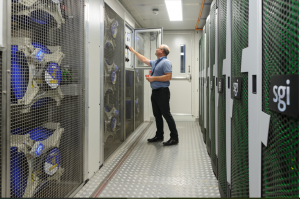NASA and Google Achieve Quantum Supremacy
Google, in partnership with NASA and Oak Ridge National Laboratory, has demonstrated the ability to compute in seconds what would take even the largest and most advanced supercomputers thousands of years, achieving a milestone known as quantum supremacy.

Electra, NASA’s powerful modular supercomputer, was also used in this collaboration with Google. It is a petascale supercomputer that saves significant amounts of water and power annually.
“Quantum computing is still in its infancy, but this transformative achievement rockets us forward,” said Eugene Tu, center director at NASA’s Ames Research Center in California’s Silicon Valley. “Our missions in the decades to come to the Moon, Mars and beyond are all fueled by innovations like this one.”
Quantum computing is the study of how to harness the unique properties of quantum mechanics to solve certain types of problems far faster than on traditional computers. Potentially, NASA could one day use these techniques to support space missions, with quantum optimization making mission schedules more efficient and quantum simulation supporting the design of light and robust materials for modern spacecraft – just to name a few applications. This milestone is the first step toward that future.
“Achieving quantum supremacy means we’ve been able to do one thing faster, not everything faster,” said Eleanor Rieffel, co-author on the paper on this result, published today in Nature, and the Quantum Artificial Intelligence Laboratory Lead at Ames. “And even though that one thing isn’t terribly useful, that it has been done at all is groundbreaking.”
The paper describes the experiments run by Google’s Sycamore quantum processor to demonstrate quantum supremacy. Computations on a quantum computer are called “quantum circuits.” These computer science abstractions work like programs, specifying a series of operations for the quantum processor to run.
The test itself involved running random quantum circuits on quantum processors as well as traditional supercomputers. Getting results from a random quantum circuit is difficult without a quantum processor, and theory suggests it may be impossible for tasks beyond a certain size, even on the largest imaginable supercomputer. You’d need more units of data than there are atoms in the universe. That’s as close as you can get to an impossible task – making it the perfect test for quantum supremacy.
Both the quantum processor and supercomputer were given increasingly complex and random circuits to compute until the supercomputer wasn’t able to process them. To find that limit, researchers at Ames advanced techniques for simulating these random quantum circuit computations using NASA’s supercomputing facilities. At a certain point, even with all the tricks NASA’s quantum computing and supercomputing experts threw at it, this simulated “computer within a computer” wasn’t able to handle the random circuits given to it – and that became the bar set for Google’s quantum computer to beat.
Source: U.S. National Aeronautics and Space Administration
- 308 reads
Human Rights
Fostering a More Humane World: The 28th Eurasian Economic Summi

Conscience, Hope, and Action: Keys to Global Peace and Sustainability

Ringing FOWPAL’s Peace Bell for the World:Nobel Peace Prize Laureates’ Visions and Actions

Protecting the World’s Cultural Diversity for a Sustainable Future

Puppet Show I International Friendship Day 2020

